微观经济学作业答案5
微观经济学作业1~4 完整答案

微观经济学作业一(导论与市场运行)一、选择题(将正确答案的标号填在题后的括号里)1.在任何一个经济中:( C )A、因为资源是稀缺的所以不会存在资源的浪费B、因为存在资源浪费,所以资源并不稀缺C、既存在资源稀缺,又存在资源浪费2.资源的稀缺性是指:( B )A、世界上的资源最终会由于人们生产更多的物品而消耗光B、相对于人们无穷的欲望而言,资源总是不足的C、生产某种物品所需资源的绝对数量很少3. 微观经济学解决的问题是:( A )A、资源配置B、资源利用C、单个经济单位如何实现最大化【微观经济学以单个经济单位为研究对象,通过研究单个经济单位的经济行为来说明市场经济如何通过价格机制来解决社会资源配置问题。
微观经济学对于居民的研究,是以居民如何将有限收入用于各种物品的消费上实现效用最大化而展开的。
微观经济学对厂商的研究是从厂商如何将有限资源用于生产实现利润最大化而展开的。
微观经济学通过对居民的效用最大化和厂商的利润最大化的研究,来探索整个社会的资源最优配置。
每个经济单位都实现了最大化,整个社会的资源配置也就达到最优化了。
】4. 宏观经济学的基本假设是:( B )A、市场出清B、市场失灵C、完全理性5. 实证经济学与规范经济学的根本区别是:( A )A、研究方法的不同B、研究对象的不同C、研究范围的不同【实证经济学和规范经济学是现代经济学的两个重要分支,是学术界对因研究方法的不同而对经济学的一种划分。
】6. 当汽油的价格上升时,小汽车的需求将:( A )A、需求曲线向左移动B、保持不变C、需求曲线向右移动【互补品】7. 当咖啡的价格急剧上升时,对茶叶的需求将:( C )A、减少B、保持不变C、增加【替代品】8.消费者预期某物品将来价格要上升,则对该物品当前需求会:( C )A、减少B、不变C、增加9.需求的变动与需求量的变动:( C )A、是一回事B、都是由于同一种原因引起的C、需求的变动由除价格以外的其它因素的变动引起的,而需求量的变动由价格的变动引起10.对化妆品需求的减少是指( A )A、收入减少而引起的减少B、价格上升而引起的减少C、与需求量的减少相同11.需求曲线通常是一条:( A )A、向右下方倾斜的曲线B、向左下方倾斜的曲线C、垂线12.在同一条需求曲线上,价格与需求量的组合从A点移动到B点是:( C )A、需求的变动B、收入的变动C、需求量的变动13. 鸡蛋的供给量增加是指:( B )A、由于鸡蛋的需求量增加而引起的增加B、由于鸡蛋的价格上升而引起的增加C、由于收入的增加而引起的增加14. 均衡价格是:( A )A、供给与需求相等时的价格B、固定不变的加格C、任何一种市场价格15. 均衡价格随着( C )。
微观经济学习题及答案第5章 生产理论
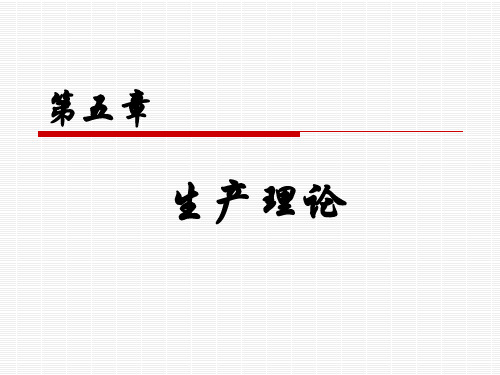
练习
4.下面是一张一种可变生产要素的短期生产函数的产量表:
可变要素数量 1 2 可变要素总量 2 12 平均产量 2 6 边际产量 2 10
3
4 5
24
48 60
8
12 12
12
24 12
6
7 8 9
66
70 70 63
11
10 8.75 7
6
4 0 -7
练习
5.如果等成本线在坐标平面上与等产量曲线相交,那么要生 产等产量曲线表示的产量水平(c) A 应增加成本支出; B 不能增加成本支出 ; C 应减少成本支出 ; D 不能减少成本支出 6.规模报酬递减是在下述情况下发生的(a) A按比例连续增加各种生产要素;B不按比例连续增加要素; C连续的投入某种生产要素而保持其他要素不变;D以上都对 7.如果等成本曲线与等产量曲线没有交点,那么要生产等产量 曲线应该(a) A增加投入;B 保持原投入不变;C 减少投入;D都不正确
练习
9.写出柯布—道格拉斯生产函数Q=ALaK1-a关于劳动的平均产 量和劳动的边际产量的生产函数。
TPL AL K 1 K 1 K 1 解:APL A 1 A( ) L L L L
1 dTP d ( AL K ) K 1 L MPL AK1 L 1 A( ) dL dL L
同样对于平均产量函数 APL 10 0.5L
dAPL 令 0, 得L2 64,L (负值舍弃) 8 dL d dAPL 64 又 ( ) 3 0; L 8为极大值点 dL dL L 即当平均产量达到极大 值时厂商雇佣的劳动为 8
32 L
dAPL 32 0 .5 2 dL L
10.用图说明短期生产函数Q=f(L、K)的TPL、APL和MPL的特 征及其相互之间的关系。
微观经济学作业(5-7章)
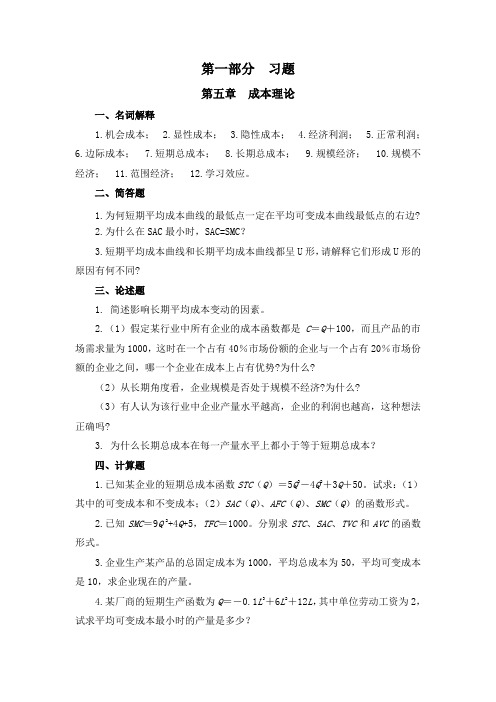
第一部分习题第五章成本理论一、名词解释1.机会成本;2.显性成本;3.隐性成本;4.经济利润;5.正常利润;6.边际成本;7.短期总成本;8.长期总成本;9.规模经济; 10.规模不经济; 11.范围经济; 12.学习效应。
二、简答题1.为何短期平均成本曲线的最低点一定在平均可变成本曲线最低点的右边?2.为什么在SAC最小时,SAC=SMC?3.短期平均成本曲线和长期平均成本曲线都呈U形,请解释它们形成U形的原因有何不同?三、论述题1. 简述影响长期平均成本变动的因素。
2.(1)假定某行业中所有企业的成本函数都是C=Q+100,而且产品的市场需求量为1000,这时在一个占有40%市场份额的企业与一个占有20%市场份额的企业之间,哪一个企业在成本上占有优势?为什么?(2)从长期角度看,企业规模是否处于规模不经济?为什么?(3)有人认为该行业中企业产量水平越高,企业的利润也越高,这种想法正确吗?3. 为什么长期总成本在每一产量水平上都小于等于短期总成本?四、计算题1.已知某企业的短期总成本函数STC(Q)=5Q3-4Q2+3Q+50。
试求:(1)其中的可变成本和不变成本;(2)SAC(Q)、AFC(Q)、SMC(Q)的函数形式。
2.已知SMC=9Q 2+4Q+5,TFC=1000。
分别求STC、SAC、TVC和AVC的函数形式。
3.企业生产某产品的总固定成本为1000,平均总成本为50,平均可变成本是10,求企业现在的产量。
4.某厂商的短期生产函数为Q=-0.1L3+6L2+12L,其中单位劳动工资为2,试求平均可变成本最小时的产量是多少?5.设某企业的生产函数为Q=min(8L,4K),且P L=2,P K=3,试求当K=10时的STC、SAC分别为多少?第六章完全竞争市场一、名词解释1. 完全竞争市场;2. 总收益;3. 平均收益;4. 边际收益;5. 收支相抵点;6. 停止营业点;7. 成本递增行业; 8. 成本递减行业; 9. 成本不变行业;10. 生产者剩余。
微观经济学习题与答案05
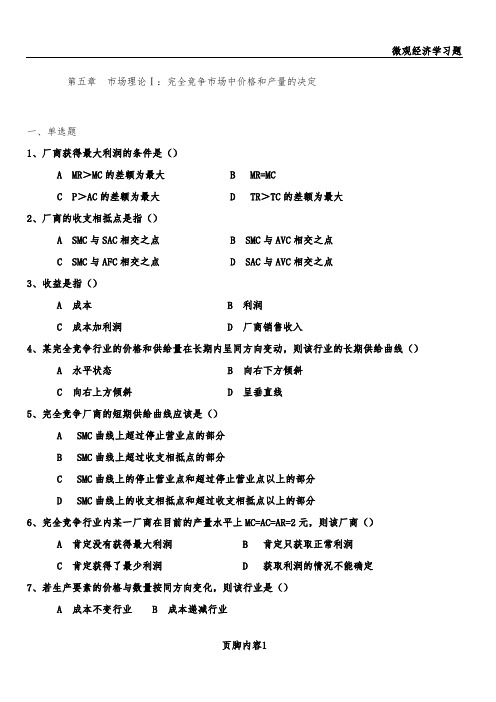
第五章市场理论Ⅰ:完全竞争市场中价格和产量的决定一、单选题1、厂商获得最大利润的条件是()A MR>MC的差额为最大B MR=MCC P>AC的差额为最大D TR>TC的差额为最大2、厂商的收支相抵点是指()A SMC与SAC相交之点B SMC与AVC相交之点C SMC与AFC相交之点D SAC与AVC相交之点3、收益是指()A 成本B 利润C 成本加利润D 厂商销售收入4、某完全竞争行业的价格和供给量在长期内呈同方向变动,则该行业的长期供给曲线()A 水平状态B 向右下方倾斜C 向右上方倾斜D 呈垂直线5、完全竞争厂商的短期供给曲线应该是()A SMC曲线上超过停止营业点的部分B SMC曲线上超过收支相抵点的部分C SMC曲线上的停止营业点和超过停止营业点以上的部分D SMC曲线上的收支相抵点和超过收支相抵点以上的部分6、完全竞争行业内某一厂商在目前的产量水平上MC=AC=AR=2元,则该厂商()A 肯定没有获得最大利润B 肯定只获取正常利润C 肯定获得了最少利润D 获取利润的情况不能确定7、若生产要素的价格与数量按同方向变化,则该行业是()A 成本不变行业B 成本递减行业C 成本递增行业D 不能确定8、在完全竞争厂商的短期均衡产量上,AR小于SAC但大于AVC,则厂商()A 亏损,立即停产B 亏损,但应继续生产C 亏损,生产或不生产都可以D 获得正常利润,继续生产9、垄断竞争厂商长期均衡的条件是()A MR=MCB MR=LMC=SMC=LAC=SACC MR=LMC=SMC AR=LAC=SACD MR=LMC=AMC10、对垄断厂商来说.下述哪种说法是不正确的()A 面临的需求曲线向右下方倾斜B 在利润最大化产量上,价格等于边际收益C 边际收益与平均收益不相等D 利润最大化产量上,价格高于边际成本二、名词解释1、市场2、完全竞争市场3、边际收益4、停止营业点5、价格歧视三、简答题1、为什么说厂商均衡的一般原则是MR=MC?2、简要分析完全竞争厂商的短期均衡。
吉大20春学期《微观经济学》在线作业一-0005参考答案

正确答案:B
5.对整体经济运行,特别是失业和通货膨胀等因素的研究,被称为:()
A.实证经济学
B.微观经济学
C.规范经济学
D.宏观经济学
正确答案:D
6.垄断竞争市场上的短期均衡的条件是()
A.MR=MC
B.AR=AC
C=LMC
D.MR=MC=AC
正确答案:A
7.当何种情况时,企业如果要使成本最低,应当停止营业()
B.用资本替代劳动
C.增加劳动投入而保持资本和土地不变
D.按既定的比例增加所有要素
正确答案:C
10.某企业每年从企业的总收入中取出一部分作为自己所提供的生产要素的报酬,这部分资金被视为()
A.显性成本
B.隐性成本
C.经济利润
D.正常利润
正确答案:B
二、多选题(共5道试题,共20分)
1.无差异曲线是凸向原点的,这说明它的斜率是( )。
A.错误
B.正确
正确答案:B
5.价格变化会引起预算线的斜率的变化。
A.错误
B.正确
正确答案:B
6.寡头垄断指一家厂商控制某种产品全部市场供给的市场结构。
A.错误
B.正确
正确答案:A
7.中国应该限制私人汽车的发展”是一个实证表述的例子。
A.错误
B.正确
正确答案:A
8.如果一个企业的平均销售收入低于平均成本,则该企业应当停产。
A.正值
B.负值
C.不变
D.绝对值递减
正确答案:BD
2.关于长期平均成本曲线,正确的说法包括()。
A.长期平均成本不大于短期平均成本
B.短期平均成本曲线的最低点在长期平均成本曲线上
微观经济学作业习题答案
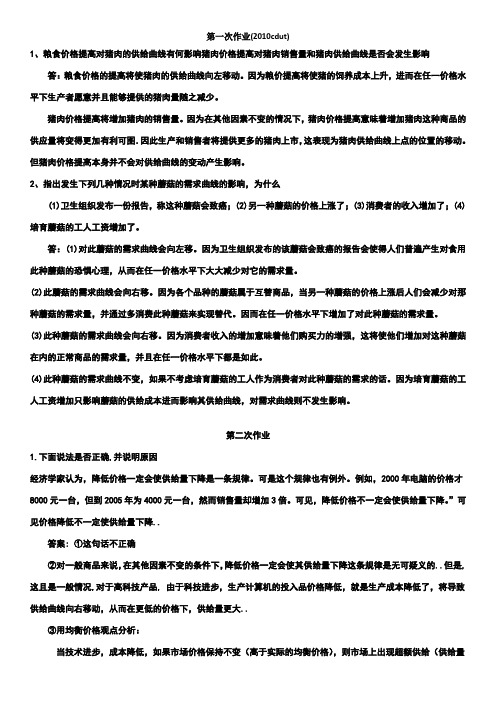
第一次作业(2010cdut)1、粮食价格提高对猪肉的供给曲线有何影响猪肉价格提高对猪肉销售量和猪肉供给曲线是否会发生影响答:粮食价格的提高将使猪肉的供给曲线向左移动。
因为粮价提高将使猪的饲养成本上升,进而在任一价格水平下生产者愿意并且能够提供的猪肉量随之减少。
猪肉价格提高将增加猪肉的销售量。
因为在其他因素不变的情况下,猪肉价格提高意味着增加猪肉这种商品的供应量将变得更加有利可图.因此生产和销售者将提供更多的猪肉上市,这表现为猪肉供给曲线上点的位置的移动。
但猪肉价格提高本身并不会对供给曲线的变动产生影响。
2、指出发生下列几种情况时某种蘑菇的需求曲线的影响,为什么(1)卫生组织发布一份报告,称这种蘑菇会致癌;(2)另一种蘑菇的价格上涨了;(3)消费者的收入增加了;(4)培育蘑菇的工人工资增加了。
答:(1)对此蘑菇的需求曲线会向左移。
因为卫生组织发布的该蘑菇会致癌的报告会使得人们普遍产生对食用此种蘑菇的恐惧心理,从而在任一价格水平下大大减少对它的需求量。
(2)此蘑菇的需求曲线会向右移。
因为各个品种的蘑菇属于互替商品,当另一种蘑菇的价格上涨后人们会减少对那种蘑菇的需求量,并通过多消费此种蘑菇来实现替代。
因而在任一价格水平下增加了对此种蘑菇的需求量。
(3)此种蘑菇的需求曲线会向右移。
因为消费者收入的增加意味着他们购买力的增强,这将使他们增加对这种蘑菇在内的正常商品的需求量,并且在任一价格水平下都是如此。
(4)此种蘑菇的需求曲线不变,如果不考虑培育蘑菇的工人作为消费者对此种蘑菇的需求的话。
因为培育蘑菇的工人工资增加只影响蘑菇的供给成本进而影响其供给曲线,对需求曲线则不发生影响。
第二次作业1.下面说法是否正确,并说明原因经济学家认为,降低价格一定会使供给量下降是一条规律。
可是这个规律也有例外。
例如,2000年电脑的价格才8000元一台,但到2005年为4000元一台,然而销售量却增加3倍。
可见,降低价格不一定会使供给量下降。
微观经济学第五章 习题答案

网友可以在线阅读和下载这些文档让每个人平等地提升自我 By :麦群超2021年春季地理物理化学复习题 练习试卷 测试题\o(K,\s\up6(-)))的产量表: 表5—L 1 2 3 4 5 6 7 TP L 10 30 70 100 120 130 135 AP L MP L (2)根据(1),在一张坐标图上作出TP L 曲线,在另一张坐标图上作出AP L 曲线和MP L 曲线。
(提示:为了便于作图与比较,TP L 曲线图的纵坐标的刻度单位大于AP L 曲线图和MP L 曲线图。
) (3)根据(1),并假定劳动的价格w =200,完成下面相应的短期成本表,即表5—2(即教材第147页的表5—3)。
L Q TVC =w·L A VC =\f(w AP L ) MC =\f(w MP L ) 1 10 2 30 3 70 4 100 5 120 6 130 7 135 线和MC 曲线。
(提示:为了便于作图与比较,TVC 曲线图的纵坐标的单位刻度大于A VC 曲线图和MC 曲线图。
) (5)根据(2)、(4),说明短期生产曲线和短期成本曲线之间的关系。
解答:(1)经填空完成的短期生产的产量表如表5—3所示: L 1 2 3 4 5 6 7 TP L 10 30 70 100 120 130 135 AP L 10 15 \f(70 3) 25 24 \f(65 3) eq \f(135 7) MP L 10 20 40 30 20 10 5 L L L 所示。
图5—1(3)令劳动的价格w=200,与(1)中的短期生产的产量表相对应的短期生产的成本表如表5—4所示:网友可以在线阅读和下载这些文档让每个人平等2021年春季地理物理化学教案等集合 1 10 200 20 20 2 30 400 \f(40 3) 10 3 70 600 \f(60 7) 5 4 100 800 8 \f(20 3) 5 120 1 000 \f(25 3) 10 6 130 1 200 \f(120 13) 20 7 135 1 400 \f(280 27) 40 (4)根据(3)中的短期生产成本表所绘制的TVC 曲线、A VC 曲线和MC 曲线如图5—2所示: 图5—2(5)公式A VC =eq \f(w,AP L )和MC =eq \f(w,MP L )已经清楚表明:在w 给定的条件下,A VC 值和AP L 值成相反方向的变化,MC 值和MP L 值也成相反方向的变化。
人大版微观经济学(第三版)课后答案第5-6章

第五章 成 本第一部分 教材配套习题本习题详解1.表5-2是一张关于短期生产函数Q ),(K L f 的产量表: 表5-2 短期生产的产量表(1)在表中填空。
(2)根据(1),在一张坐标图上做出TP L 曲线,在另一张坐标图上作出AP L 曲线和MP L 曲线。
(提示:为了便于作图与比较,TP L 曲线图的纵坐标的刻度单位通常大于AP L 曲线图和MP L 曲线图。
) (3)根据(1),并假定劳动的价格w=200,完成下面的相应的短期成本表,即表5-3. 表5-3 短期生产的成本表(4)根据表5-3,在一张坐标图上做出TVC 曲线,在另一张坐标图上作出AVC 曲线和MC 曲线。
(提示:为了便于作图与比较,TVC 曲线图的纵坐标的刻度单位通常大于AVC 曲线图和MC 曲线图。
)(5)根据(2)(4),说明短期生产曲线和短期成本曲线之间的关系。
解答:(1)补充完整的短期生产的产量表如表5-3所示。
表5-3(2)总产量曲线如图5—1所示,平均产量曲线、边际产量曲线如图5—2所示。
图5—1总产量曲线 图5—2 平均产量曲线和边际产量曲线(3)补充完整的短期生产的成本表如表5—4所示。
表5—46 130 1200 12013 20 713514002802740(4)总可变成本曲线如图5—3所示,平均可变成本曲线、边际成本曲线如图5—4所示。
图5—3 总可变成本曲线 图5—4 平均可变成本曲线和边际成本曲线(5)从图形可以看出,当边际产量高于平均产量时,平均产量上升,此时边际成本和平均成本下降。
当边际产量低于平均产量时,平均产量下降,此时边际成本和平均成本上升。
当边际产量上升时,边际成本下降,总产量上升,总可变成本以递减速率上升。
当边际产量等于平均产量时,边际成本等于平均成本,此时平均产量最大而平均可变成本最小。
2.假定某企业的短期成本函数是TC =Q 3-10Q 2+17Q+66,求: (1)指出该短期总成本函数中的可变成本部分和不变成本部分;(2)写出下列相应的函数:TVC(Q)、AC(Q)、AVC(Q)、AFC(Q)、MC(Q)。
西方经济学(微观经济学)课后练习答案第五章

一、名词解释机会成本沉没成本显性成本隐性成本成本函数短期总固定成本短期总可变成本短期边际成本长期总成本长期平均成本长期边际成本二、选择题1、经济学中短期与长期划分取决于( D )A.时间长短 B.可否调整产量C.可否调整产品价格 D.可否调整生产规模2、经济学中,生产的机会成本等于()A、显性成本+隐性成本B、显性成本+社会成本C、会计成本+隐性成本D、社会成本+隐性成本3、以下关于正常利润的说法不正确的是()A、正常利润是厂商对自己所提供的企业家才能所支付的报酬B、正常利润是隐性成本的一个组成部分C、正常利润是显性成本的一个组成部分D、经济利润中不包括正常利润4、下列说法哪个是正确的( A )A.如果连续的增加某种商品的产量,它的机会成本将递增B.短期平均成本呈现为“U”型,是由于机会成本递增C.经济分析中厂商的生产成本与机会成本这两个词是同义词D.如果一个人选择了上学而不是工作,那他的机会成本等于学习期间的学费5、短期可变成本曲线随着产量的增加而()A、不断上升B、不断下降C、先上升再下降D、先下降再上升6、当边际成本达到最低点时()A、平均成本曲线呈现递减状态B、平均可变成本曲线呈现递增状态C、平均产量曲线达到最大值D、总产量曲线达到最大值7、当边际成本曲线上升时,其对应的平均可变成本曲线一定是()A、上升B、下降C、既不上升,也不下降D、既可能上升,也可能下降8、短期内边际产量最高点对应于()A、边际成本最低点B、平均成本最低点C、平均可变成本最低点D、平均产量最高点9、长期边际成本曲线呈现U型形状的原因是()A、边际效用递减规律B、边际收益递减规律C、生产由规模经济向规模不经济变动D、生产的一般规律10、从长期成本和短期成本曲线的关系来看,在对应LTC与STC切点处有( A )A.LTC=STC且LAC=SAC,LMC=SMCB.LTC=STC但LAC<SAC,LMC<SMCC.LTC=STC但LAC>SAC,LMC>SMCD.LTC=STC且LAC=SAC但LMC≠SMC11、以下关于边际成本曲线、总成本曲线和可变成本曲线的说法正确的是()A、当边际成本曲线下降时,总成本曲线以越来越慢的速度下降B、当边际成本曲线下降时,可变成本曲线以越来越快的速度下降C、当边际成本曲线上升时,总成本曲线以越来越快的速度上升D、当边际成本曲线上升时,可变成本曲线以越来越慢的速度上升12、若某个产量的长期平均成本等于短期平均成本,但高于长期边际成本,则()A、规模报酬处于递减阶段B、长期平均成本正在下降C、短期平均成本最小D、短期平均成本等于长期边际成本三、判断题1、由于固定成本不随产出的变化而变化,因而平均固定成本也不变化。
微观经济学第五章答案
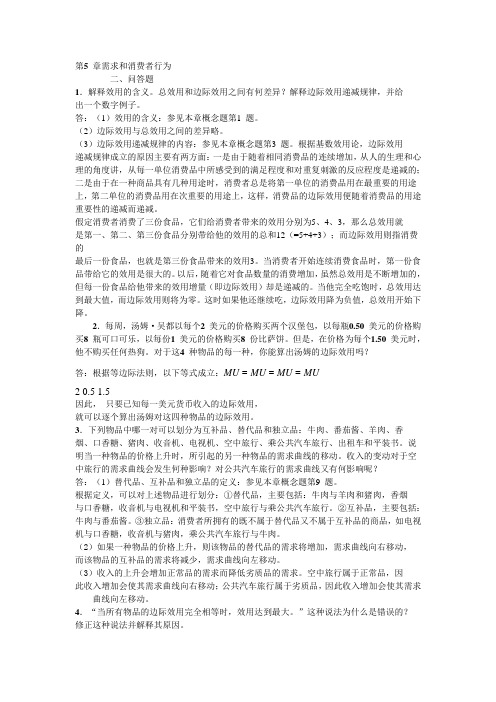
第5 章需求和消费者行为二、问答题1.解释效用的含义。
总效用和边际效用之间有何差异?解释边际效用递减规律,并给出一个数字例子。
答:(1)效用的含义:参见本章概念题第1 题。
(2)边际效用与总效用之间的差异略。
(3)边际效用递减规律的内容:参见本章概念题第3 题。
根据基数效用论,边际效用递减规律成立的原因主要有两方面:一是由于随着相同消费品的连续增加,从人的生理和心理的角度讲,从每一单位消费品中所感受到的满足程度和对重复刺激的反应程度是递减的;二是由于在一种商品具有几种用途时,消费者总是将第一单位的消费品用在最重要的用途上,第二单位的消费品用在次重要的用途上,这样,消费品的边际效用便随着消费品的用途重要性的递减而递减。
假定消费者消费了三份食品,它们给消费者带来的效用分别为5、4、3,那么总效用就是第一、第二、第三份食品分别带给他的效用的总和12(=5+4+3);而边际效用则指消费的最后一份食品,也就是第三份食品带来的效用3。
当消费者开始连续消费食品时,第一份食品带给它的效用是很大的。
以后,随着它对食品数量的消费增加,虽然总效用是不断增加的,但每一份食品给他带来的效用增量(即边际效用)却是递减的。
当他完全吃饱时,总效用达到最大值,而边际效用则将为零。
这时如果他还继续吃,边际效用降为负值,总效用开始下降。
2.每周,汤姆·吴都以每个2 美元的价格购买两个汉堡包,以每瓶0.50 美元的价格购买8 瓶可口可乐,以每份1 美元的价格购买8 份比萨饼。
但是,在价格为每个1.50 美元时,他不购买任何热狗。
对于这4 种物品的每一种,你能算出汤姆的边际效用吗?答:根据等边际法则,以下等式成立:MU = MU = MU = MU2 0.5 1.5因此,只要已知每一美元货币收入的边际效用,就可以逐个算出汤姆对这四种物品的边际效用。
3.下列物品中哪一对可以划分为互补品、替代品和独立品:牛肉、番茄酱、羊肉、香烟、口香糖、猪肉、收音机、电视机、空中旅行、乘公共汽车旅行、出租车和平装书。
微观经济学习题及答案

第一章导言(一)单项选择题1.经济学产生的原因是()。
A. 生产的需要B. 欲望满足的需要C. 稀缺性的存在与选择的必要D. 选择的需要2.经济学的研究对象是()。
A. 资源配置B. 资源配置和资源利用C. 经济体制D. 资源利用3.微观经济学的中心是()。
A. 价格决定B. 产量决定C. 成本决定D. 利润决定4.( )不是宏观经济学的内容A. 收入决定B. 物价水平C. 经济增长D. 厂商均衡5.经济学的研究方法包括( )。
A. 经济模型B. 静态分析、比较静态和动态分析C. 局部均衡分析与一般均衡分析D. A、B、C(一)单项选择题1. C2. B3. A4. D5. D第二章需求、供给与均衡价格的决定(一)单项选择1.需求曲线上任意一点对应的价格是()。
A. 均衡价格B. 市场价格C. 需求价格D. 最低价格2.在其他条件不变的情况下,消费者收入增加将导致()。
A. 需求量增加B. 需求增加C. 需求量减少D. 需求减少3.下列因素中不能导致需求曲线移动的因素是()。
A. 相关商品的价格不变B. 消费者的价格预期C. 消费者的收入水平D. 商品自身的价格4.两种互补商品中的一种价格下降将导致另一种商品的()上升。
A. 需求量B. 需求C. 价格D. 均衡价格5.一种商品的价格下降会导致其替代商品的需求曲线()。
A. 向左方移动B. 向右方移动C. 不变D. 以上三种情况都有可能6.如果一条线性需求曲线与一条非线性需求曲线相切,则切点处两条需求曲线的价格点弹性系数( )。
A. 相同B. 不同C. 可能相同也可能不同D. 根据切点的位置而定7.如果某种商品的供给曲线斜率为正,在保持其他因素不变的情况下,该商品的生产技术水平有所提高,必将导致( )。
A. 供给量增加B. 供给量减少C. 供给增加D. 供给减少8.某商品的价格上升,其销售收益非但没有增加,反而减少了,这是因为该商品的需求是( )。
微观经济学作业题及参考答案080430
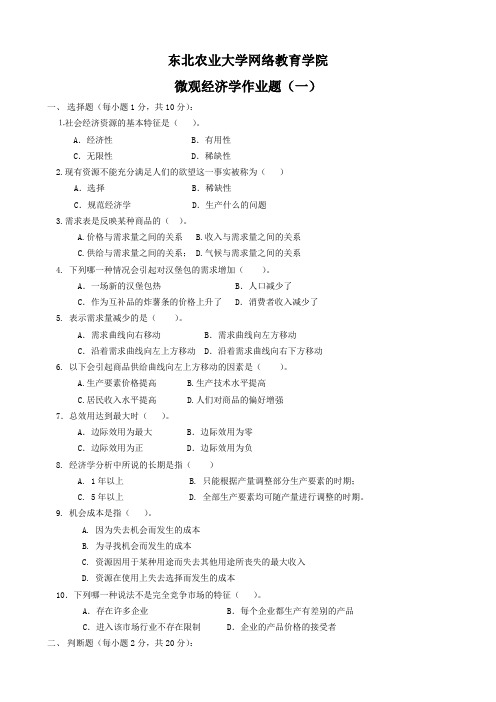
东北农业大学网络教育学院微观经济学作业题(一)一、选择题(每小题1分,共10分):⒈社会经济资源的基本特征是()。
A.经济性 B.有用性C.无限性 D.稀缺性2.现有资源不能充分满足人们的欲望这一事实被称为()A.选择 B.稀缺性C.规范经济学 D.生产什么的问题3.需求表是反映某种商品的()。
A.价格与需求量之间的关系B.收入与需求量之间的关系C.供给与需求量之间的关系;D.气候与需求量之间的关系4. 下列哪一种情况会引起对汉堡包的需求增加()。
A.一场新的汉堡包热 B.人口减少了C.作为互补品的炸薯条的价格上升了 D.消费者收入减少了5. 表示需求量减少的是()。
A.需求曲线向右移动 B.需求曲线向左方移动C.沿着需求曲线向左上方移动 D.沿着需求曲线向右下方移动6. 以下会引起商品供给曲线向左上方移动的因素是()。
A.生产要素价格提高B.生产技术水平提高C.居民收入水平提高D.人们对商品的偏好增强7.总效用达到最大时()。
A.边际效用为最大B.边际效用为零C.边际效用为正D.边际效用为负8. 经济学分析中所说的长期是指()A. 1年以上B. 只能根据产量调整部分生产要素的时期;C. 5年以上D. 全部生产要素均可随产量进行调整的时期。
9. 机会成本是指()。
A. 因为失去机会而发生的成本B. 为寻找机会而发生的成本C. 资源因用于某种用途而失去其他用途所丧失的最大收入D. 资源在使用上失去选择而发生的成本10.下列哪一种说法不是完全竞争市场的特征()。
A.存在许多企业 B.每个企业都生产有差别的产品C.进入该市场行业不存在限制 D.企业的产品价格的接受者1.资源的稀缺性是经济学产生的前提。
()2. “人们的收入差距是大一点好还是小一点好”的命题属于实证经济学问题。
()3.生活必需品通常缺乏需求价格弹性。
()4.生产要素的边际技术替代率递减是由于边际产量递减。
()5.在短期内,边际产量曲线一定会交于平均产量曲线的最高点。
微观经济学作业题及参考答案080430
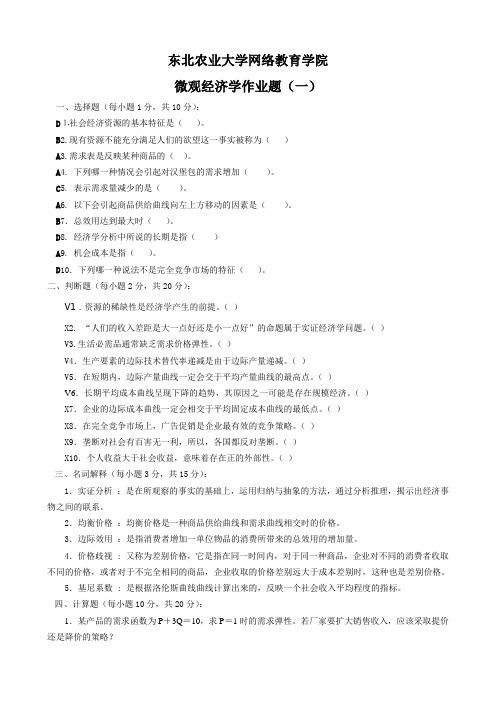
东北农业大学网络教育学院微观经济学作业题(一)一、选择题(每小题1分,共10分):D⒈社会经济资源的基本特征是()。
B2.现有资源不能充分满足人们的欲望这一事实被称为()A3.需求表是反映某种商品的()。
A4. 下列哪一种情况会引起对汉堡包的需求增加()。
C5. 表示需求量减少的是()。
A6. 以下会引起商品供给曲线向左上方移动的因素是()。
B7.总效用达到最大时()。
D8. 经济学分析中所说的长期是指()A9. 机会成本是指()。
D10.下列哪一种说法不是完全竞争市场的特征()。
二、判断题(每小题2分,共20分):V1.资源的稀缺性是经济学产生的前提。
()X2. “人们的收入差距是大一点好还是小一点好”的命题属于实证经济学问题。
()V3.生活必需品通常缺乏需求价格弹性。
()V4.生产要素的边际技术替代率递减是由于边际产量递减。
()V5.在短期内,边际产量曲线一定会交于平均产量曲线的最高点。
()V6.长期平均成本曲线呈现下降的趋势,其原因之一可能是存在规模经济。
()X7.企业的边际成本曲线一定会相交于平均固定成本曲线的最低点。
()X8.在完全竞争市场上,广告促销是企业最有效的竞争策略。
()X9.垄断对社会有百害无一利,所以,各国都反对垄断。
()X10.个人收益大于社会收益,意味着存在正的外部性。
()三、名词解释(每小题3分,共15分):1.实证分析:是在所观察的事实的基础上,运用归纳与抽象的方法,通过分析推理,揭示出经济事物之间的联系。
2.均衡价格:均衡价格是一种商品供给曲线和需求曲线相交时的价格。
3.边际效用:是指消费者增加一单位物品的消费所带来的总效用的增加量。
4.价格歧视 :又称为差别价格,它是指在同一时间内,对于同一种商品,企业对不同的消费者收取不同的价格,或者对于不完全相同的商品,企业收取的价格差别远大于成本差别时,这种也是差别价格。
5.基尼系数 : 是根据洛伦斯曲线曲线计算出来的,反映一个社会收入平均程度的指标。
微观经济学习题与答案05
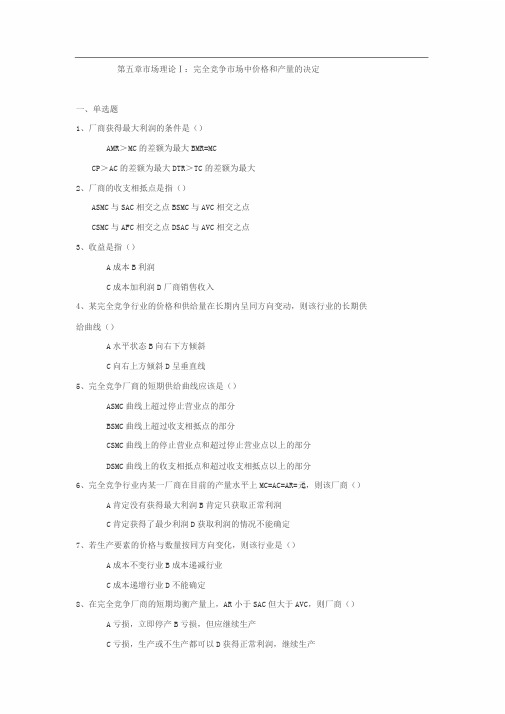
第五章市场理论Ⅰ:完全竞争市场中价格和产量的决定一、单选题1、厂商获得最大利润的条件是()AMR>MC的差额为最大BMR=MCCP>AC的差额为最大DTR>TC的差额为最大2、厂商的收支相抵点是指()ASMC与SAC相交之点BSMC与AVC相交之点CSMC与AFC相交之点DSAC与AVC相交之点3、收益是指()A成本B利润C成本加利润D厂商销售收入4、某完全竞争行业的价格和供给量在长期内呈同方向变动,则该行业的长期供给曲线()A水平状态B向右下方倾斜C向右上方倾斜D呈垂直线5、完全竞争厂商的短期供给曲线应该是()ASMC曲线上超过停止营业点的部分BSMC曲线上超过收支相抵点的部分CSMC曲线上的停止营业点和超过停止营业点以上的部分DSMC曲线上的收支相抵点和超过收支相抵点以上的部分6、完全竞争行业内某一厂商在目前的产量水平上MC=AC=AR=元2,则该厂商()A肯定没有获得最大利润B肯定只获取正常利润C肯定获得了最少利润D获取利润的情况不能确定7、若生产要素的价格与数量按同方向变化,则该行业是()A成本不变行业B成本递减行业C成本递增行业D不能确定8、在完全竞争厂商的短期均衡产量上,AR小于SAC但大于AVC,则厂商()A亏损,立即停产B亏损,但应继续生产C亏损,生产或不生产都可以D获得正常利润,继续生产9、垄断竞争厂商长期均衡的条件是()AMR=MCBMR=LMC=SMC=LAC=SACCMR=LMC=SMCAR=LAC=SACDMR=LMC=AMC10、对垄断厂商来说.下述哪种说法是不正确的()A面临的需求曲线向右下方倾斜B在利润最大化产量上,价格等于边际收益C边际收益与平均收益不相等D利润最大化产量上,价格高于边际成本二、名词解释1、市场2、完全竞争市场3、边际收益4、停止营业点5、价格歧视三、简答题1、为什么说厂商均衡的一般原则是MR=M?C2、简要分析完全竞争厂商的短期均衡。
3、为什么说完全竞争厂商是市场价格的接受者?4、利润最大、亏损最小的原则为什么是边际收益等于边际成本定理?为什么在完全竞争条件下,该定理可以表述为MC=P?5、为什么完全竞争厂商的需求曲线为一条水平线,且有P=AR=M?R6、为什么企业在短期内亏本还会继续经营?企业短期内在什么情况下应当关门?企业能否长期亏本经营?7、用图说明完全竞争厂商短期均衡的形成及其条件,并推导厂商的短期供给曲线。
微观经济学第5章 成本论习题与答案
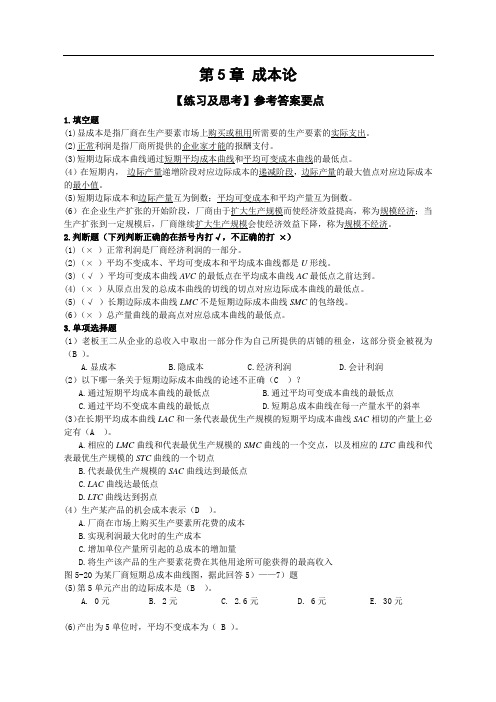
第5章成本论【练习及思考】参考答案要点1.填空题(1)显成本是指厂商在生产要素市场上购买或租用所需要的生产要素的实际支出。
(2)正常利润是指厂商所提供的企业家才能的报酬支付。
(3)短期边际成本曲线通过短期平均成本曲线和平均可变成本曲线的最低点。
(4)在短期内,边际产量递增阶段对应边际成本的递减阶段,边际产量的最大值点对应边际成本的最小值。
(5)短期边际成本和边际产量互为倒数;平均可变成本和平均产量互为倒数。
(6)在企业生产扩张的开始阶段,厂商由于扩大生产规模而使经济效益提高,称为规模经济;当生产扩张到一定规模后,厂商继续扩大生产规模会使经济效益下降,称为规模不经济。
2.判断题(下列判断正确的在括号内打√,不正确的打×)(1)(×)正常利润是厂商经济利润的一部分。
(2)(×)平均不变成本、平均可变成本和平均成本曲线都是U形线。
(3)(√)平均可变成本曲线AVC的最低点在平均成本曲线AC最低点之前达到。
(4)(×)从原点出发的总成本曲线的切线的切点对应边际成本曲线的最低点。
(5)(√)长期边际成本曲线LMC不是短期边际成本曲线SMC的包络线。
(6)(×)总产量曲线的最高点对应总成本曲线的最低点。
3.单项选择题(1)老板王二从企业的总收入中取出一部分作为自己所提供的店铺的租金,这部分资金被视为(B )。
A.显成本B.隐成本C.经济利润D.会计利润(2)以下哪一条关于短期边际成本曲线的论述不正确(C )?A.通过短期平均成本曲线的最低点B.通过平均可变成本曲线的最低点C.通过平均不变成本曲线的最低点D.短期总成本曲线在每一产量水平的斜率(3)在长期平均成本曲线LAC和一条代表最优生产规模的短期平均成本曲线SAC相切的产量上必定有(A )。
A.相应的LMC曲线和代表最优生产规模的SMC曲线的一个交点,以及相应的LTC曲线和代表最优生产规模的STC曲线的一个切点B.代表最优生产规模的SAC曲线达到最低点C曲线达最低点D.LTC曲线达到拐点(4)生产某产品的机会成本表示(D )。
微观经济学网络作业答案

微观经济学网络作业答案题号:1 题型:单选题(请在以下几个选项中选择唯一正确答案)本题分数:5内容:如果某商品需求的价格弹性是缺乏弹性,则该商品价格上升()。
A、会使销售收益增加B、该商品销售收益不变C、会使销售收益下降D、销售收益可能增加也可能减少标准答案:A学员答案:D本题得分:01728394danx题号:2 题型:单选题(请在以下几个选项中选择唯一正确答案)本题分数:5内容:按照凯恩斯的消费心理规律,以下说法正确的是()。
A、边际消费倾向等于1B、边际消费倾向大于1C、边际消费倾向小于1D、边际消费倾向小于0标准答案:C学员答案:C本题得分:51728395danx题号:3 题型:单选题(请在以下几个选项中选择唯一正确答案)本题分数:5内容:消费者预期某物品未来价格要上涨,则对该物品当前的需求会()A、减少B、增加C、不变D、上述三种情况均可能标准答案:B学员答案:B本题得分:51728396danx题号:4 题型:单选题(请在以下几个选项中选择唯一正确答案)本题分数:5内容:若某消费者消费了两单位某物品之后,得之边际效用为零,则此时()。
A、消费者获得了最大平均效用B、消费者获得的总效用最大C、消费者获得的总效用最小D、消费者所获得的总效用为负标准答案:B学员答案:B本题得分:51728397danx题号:5 题型:单选题(请在以下几个选项中选择唯一正确答案)本题分数:5内容:如果在厂商的均衡产量上,AR小于SAC,但大于AVC,则厂商()A、亏损,立即停产B、亏损但继续生产C、亏损,生产或不生产均可D、获得正常利润,继续生产标准答案:B学员答案:B本题得分:51728398danx题号:6 题型:单选题(请在以下几个选项中选择唯一正确答案)本题分数:5内容:某商品的消费量随着消费者收入的增加而减少,则该商品是()A、替代品B、互补品C、正常品D、低档品。
标准答案:D学员答案:D本题得分:51728399danx题号:7 题型:单选题(请在以下几个选项中选择唯一正确答案)本题分数:5内容:如果商品A和商品B是替代的,则A的价格下降将造成()。
大学微观经济学考试练习题及答案511

大学微观经济学考试练习题及答案51.[单选题]某消费者曲线上的各点A)表示该消费者的效用最大点B)不表示效用最大点C)有可能表示效用最大点答案:A解析:2.[单选题]在微观经济学中,短期与长期的划分标准是( )。
A)是否可以调整产量B)是否可以调整产品价格C)时间长短D)是否可以调整全部生产要素的数量答案:D解析:3.[单选题]移动通信行业在长期应该属于A)成本递增行业B)成本不变行业C)成本递减行业D)不能确定答案:C解析:4.[单选题]完全竞争厂商的长期均衡产量上,一定有( )。
A)P=LMC≠SMCB)P=LMC=SMC≠LACC)P=LMC=SMC=LAC≠SACD)P=LMC=SMC=LAC=SAC答案:D解析:5.[单选题]当完全竞争市场实现长期均衡时A)一个厂商都得到了正常利润B)一个厂商的经济利润都为0C)业中没有厂商再进入或退出D)上均对答案:D解析:6.[单选题]短期平均成本曲线为U型的原因在于( )A)边际效应递减规律B)边际收益(报酬,产量)递减C)生产由规模经济向规模不经济变动D)生产的一般规律答案:B解析:7.[单选题]洛伦茨曲线代表了( )。
A)贫困的程度B)税收体制的效率C)收入不平均的程度D)税收体制的透明度答案:C解析:8.[单选题]某完全竞争企业面临的产品市场价格P为每个单位10元,平均成本AC每个单位14元,其中平均固定成本AFC为每个单位3元。
问该企业当前的对决策是A)按14元价格销售B)按11元价格销售C)短期内继续生产D)立即停止生产答案:D解析:9.[单选题]题目A)边际报酬递增B)边际报酬递减C)规模收益递增D)规模收益递减答案:B解析:10.[单选题]垄断竞争市场长期均衡时,厂商的( )。
A)平均收益等于长期平均成本B)边际收益等于长期边际成本C)价格等于平均成本D)以上都对答案:D解析:11.[单选题]你为某物付多少钱和你愿意为之付多少钱(支付意愿)之间的区别叫( )A)总效用B)边际效用C)消费者需求D)消费者剩余答案:D解析:12.[单选题]某种生产要素的市场(或行业)需求曲线与单个场商对该种生产要素的需求曲线相比较,( )。
微观经济学作业(答案)
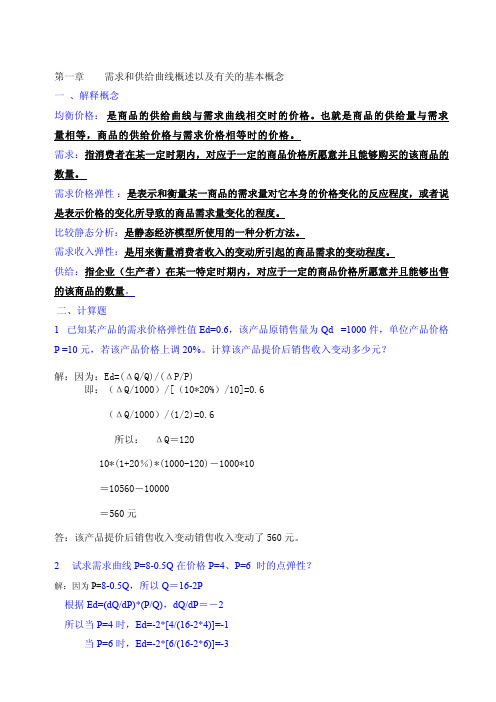
第一章需求和供给曲线概述以及有关的基本概念一、解释概念均衡价格:是商品的供给曲线与需求曲线相交时的价格。
也就是商品的供给量与需求量相等,商品的供给价格与需求价格相等时的价格。
需求:指消费者在某一定时期内,对应于一定的商品价格所愿意并且能够购买的该商品的数量。
需求价格弹性:是表示和衡量某一商品的需求量对它本身的价格变化的反应程度,或者说是表示价格的变化所导致的商品需求量变化的程度。
比较静态分析:是静态经济模型所使用的一种分析方法。
需求收入弹性:是用来衡量消费者收入的变动所引起的商品需求的变动程度。
供给:指企业(生产者)在某一特定时期内,对应于一定的商品价格所愿意并且能够出售的该商品的数量。
二、计算题1 已知某产品的需求价格弹性值Ed=0.6,该产品原销售量为Qd =1000件,单位产品价格P =10元,若该产品价格上调20%。
计算该产品提价后销售收入变动多少元?解:因为:Ed=(ΔQ/Q)/(ΔP/P)即:(ΔQ/1000)/[(10*20%)/10]=0.6(ΔQ/1000)/(1/2)=0.6所以: ΔQ=12010*(1+20%)*(1000-120)-1000*10=10560-10000=560元答:该产品提价后销售收入变动销售收入变动了560元。
2 试求需求曲线P=8-0.5Q在价格P=4、P=6 时的点弹性?解:因为P=8-0.5Q,所以Q=16-2P根据Ed=(dQ/dP)*(P/Q),dQ/dP=-2所以当P=4时,Ed=-2*[4/(16-2*4)]=-1当P=6时,Ed=-2*[6/(16-2*6)]=-33 某地牛奶产量为100吨,社会需求量为120吨,牛奶的需求弹性系数为0.5,原价格为每吨500元,当价格上升为多少元时,才能使供给=需求?解:因为:Ed=(ΔQ/ΔP)*( P /Q)即:(20/ΔP)*(500/120)=0.5ΔP=166.7上升后价格为:500+166.7=666.7元答:当价格上升为6667.元时,才能使供给=需求。
微观经济学答案 第5--6章【范本模板】

第五章生产理论(一)已完成1提供劳务的生产产业称为:•A、第一次生产•B、第二次生产•C、第三次生产•D、低级生产我的答案:C2以下哪个选项不属于SNA的主要指标:•A、GDP•B、NI•C、GNP•D、CPI我的答案:D3第一次生产或称:•A、初级生产•B、次级生产•C、初步生产•D、高级生产我的答案:A4按照产业分类,下列是第三产业的部门是()•A、加工工业•B、渔业•C、电力行业•D、建筑业我的答案:C5第一次产业指直接利用()资源创造或增加效用的生产,其产品是初级产品。
•A、自然•B、再生•C、人力•D、综合我的答案:A6对初级产品进行加工,创造或增加()效用的生产,其产品称为次级产品,这是第二次产业。
•A、总•B、边际•C、平均•D、形态我的答案:D7第三次生产或称为次级生产.我的答案:×8GNP高的地方代表该地的GDP也很高。
我的答案:×9除物质生产外的所有劳务活动,能够创造或增加物质的所有权、空间、时间等效用。
我的答案:√10城市的供水行业是属于第二产业。
我的答案:×生产理论(二)已完成1SNA和MPS的主要指标中相同的是什么?•A、工业总产值•B、农业总产值•C、国民收入•D、工农总产值我的答案:C2最简单的厂商组织是什么?•A、个人企业•B、合伙企业•C、公司企业•D、合作企业我的答案:A3经济活动的国际标准分类中建筑业属于哪一产业?•A、第一产业•B、第二产业•C、第三产业•D、新兴产业我的答案:B4美国在2000年第二产业在GDP构成中的比重是多少? •A、0。
72•B、0.527•C、0.332•D、0.263我的答案:D5以下哪个选项不属于按责任划分的公司类型:•A、股份公司•B、有限责任公司•C、无限责任公司•D、两合公司我的答案:A6建筑业属于:•A、初次产业•B、第一产业•C、第二产业•D、第三产业我的答案:C7金融业属于:•A、初次产业•B、第一产业•C、第二产业•D、第三产业我的答案:D8依据配第—克拉克定律,在农业经济中,三产的比重关系是()•A、不确定•B、三产>二产>一产•C、二产〉三产>一产•D、一产>二产>三产我的答案:D9在现代经济中,按照配第—克拉克定律,三产的比重关系是() •A、不确定•B、三产〉二产>一产•C、二产〉三产>一产•D、一产〉二产>三产我的答案:B10MPS体系是将()不包含在产业中。
微观经济学习题与答案05

第五章市场理论Ⅰ:完全竞争市场中价格和产量的决定一、单选题1、厂商获得最大利润的条件是()A MR>MC的差额为最大B MR=MCC P>AC的差额为最大D TR>TC的差额为最大2、厂商的收支相抵点是指()A SMC与SAC相交之点B SMC与AVC相交之点C SMC与AFC相交之点D SAC与AVC相交之点3、收益是指()A 成本B 利润C 成本加利润D 厂商销售收入4、某完全竞争行业的价格和供给量在长期呈同方向变动,则该行业的长期供给曲线()A 水平状态B 向右下方倾斜C 向右上方倾斜D 呈垂直线5、完全竞争厂商的短期供给曲线应该是()A SMC曲线上超过停止营业点的部分B SMC曲线上超过收支相抵点的部分C SMC曲线上的停止营业点和超过停止营业点以上的部分D SMC曲线上的收支相抵点和超过收支相抵点以上的部分6、完全竞争行业某一厂商在目前的产量水平上MC=AC=AR=2元,则该厂商()A 肯定没有获得最大利润B 肯定只获取正常利润C 肯定获得了最少利润D 获取利润的情况不能确定7、若生产要素的价格与数量按同方向变化,则该行业是()A 成本不变行业B 成本递减行业C 成本递增行业D 不能确定8、在完全竞争厂商的短期均衡产量上,AR小于SAC但大于AVC,则厂商()A 亏损,立即停产B 亏损,但应继续生产C 亏损,生产或不生产都可以D 获得正常利润,继续生产9、垄断竞争厂商长期均衡的条件是()A MR=MCB MR=LMC=SMC=LAC=SACC MR=LMC=SMC AR=LAC=SACD MR=LMC=AMC10、对垄断厂商来说.下述哪种说法是不正确的()A 面临的需求曲线向右下方倾斜B 在利润最大化产量上,价格等于边际收益C 边际收益与平均收益不相等D 利润最大化产量上,价格高于边际成本二、名词解释1、市场2、完全竞争市场3、边际收益4、停止营业点5、价格歧视三、简答题1、为什么说厂商均衡的一般原则是MR=MC?2、简要分析完全竞争厂商的短期均衡。
- 1、下载文档前请自行甄别文档内容的完整性,平台不提供额外的编辑、内容补充、找答案等附加服务。
- 2、"仅部分预览"的文档,不可在线预览部分如存在完整性等问题,可反馈申请退款(可完整预览的文档不适用该条件!)。
- 3、如文档侵犯您的权益,请联系客服反馈,我们会尽快为您处理(人工客服工作时间:9:00-18:30)。
Managerial EconomicsHOMEWORK SET#5Name:Class:Student #:(Due day: Next class)Part 1:1. Discrimination based upon the quantity consumed is referred to as ______________ price discrimination.a. first-degreeb. second degreec. third-degreed. groupChoose:b)2. Club Med, which runs a number of vacation resorts, offers vacation packages ata lower price in the winter, the "off season," than in the summer. This practice is an example of:a. peak-load pricing.b. intertemporal price discrimination.c. two-part tariff.d. bundling.e. both (a) and (b) are correct.Choose:e)3. Bundling raises higher revenues than selling the goods separately whena. demands for two goods are highly positively correlated.b. demands for two products are mildly positively correlated.c. demands for two products are negatively correlated.d. there is a perfect positive correlation between the demands for two goods.e. the goods are complementary in nature.Choose:c)4. Two-part tariffs are:a. a form of bundling.b. profit-enhancing if consumers have different demand curves.c. inefficient if all consumers are idential.d. an uncommon price strategy.e. None of the above is correct.Choose:b) Although not all surplus can be extracted when consumers's demand differs, two part tariffs may still be profitable. Two-part tariffs can be just as efficient as perfect competition if consumers are identical snd price is set at marginal cost(therefore, choice c) is wrong). Choice d) is certainly not true-separating prices into two components, an entry fee and a usage fee, is quite common. Example are country club pricing or fitness club pricing (an initial membership fee and monthly fees as well) and utility bills (a charge for being connected and a separate charge for ueage.)The next four questiones refer to the Zwift Corporation, which has a monopoly inthe Zouvenier market in Zuburbia. Zwift has a constant average variable cost of $5 per unit and no fixed costs. It faces the demand curve P=85-2Q, where P is measured in dollars.5. Zwift should produce an output of:a. 42.5 units.b. 40 units.c. 20 units.d. 10 units.e. None of the above is correct.Choose: c) MR=85-4Q. At MR=MC, 85-4Q=5,or Q*=20.6. It should charge a price per unit of:a. $45.b. $5.c. $85.d. $10.e. None of the above is correct.Choose: a) At Q*=20, P*=85-2(20)=$45.7. At the profit-maximizing output, it will earn profits of:a. $1,700.b. $1,600.c. $800.d. $400.e. None of the above is correct.Choose:c) With zero fixed costs, ATC=AVC, and profit equals TR-TC=45(20)-5(20)=$800.8. The deadweight loss from Zwift's monopoly is:a. $400.b. $800.c. $900.d. $1,600.e. $1,806.25.Choose:a) The competitive price and output would be P*=MC=5 and therefore 5=85-2Q or Q*=40. Deadweight loss is then the area of the triangle bordered by the competitive and monopoly outcome: 0.5(40-20)(45-5)=$400.The next two questions use the following data: Forty thousand potential customers of a cable TV franchise are each willing to pay $6/month for HBO and $6/month for Cinemax. Twenty thousand potential customers are each willing to pay $10/month for HBO and only $3/month for Cinemax. Assume costs are zero.9. If the two services are sold separately, the franchise should charge ( ) for HBO and ( ) for Cinemax.a. $10 and $6b. $6 and $6c. $6 and $10d. $6 and $3e. $10 and $3Choose:b) The cable franchise would earn revenues of $6(40,000)+6(20,000)=$360,000 if it set PHBO=$6. It would earn revenues of 10(20,000)=$200,000 if PHBO=$10. Therefore, the cable franchise should set PHBO=$6.10. If the franchise sells the two services in a bundle, it should charge:a. $16.b. $13.c. $12.d. $10.e. $9.Choose:c) If the cable company charges a bundle price of $12 then revenue is (40,000+20,000)12=$720,000. If the bundle price were $13, revenues would be 13(20,000)=$260,000. Note that bundling induces all customers to buy both services. Even though the total price($12) is the same as in Question 7, bundling is more profitable.11. Comparing first-degree price discrimination to perfect competition one can conclude that:a. total surplus is higher under competition.b. total surplus is lower under competition.c. producer surplus is lower and consumer surplus is higher under competition.d. marginal revenue is equal to price under competition, but not under first-degree price discrimination.e. deadweight loss is lower under competition.Choose:c) First-degree price discrimination uses different packaging or distribution methods for its generic cigarettes, the price difference may partially reflect a cost difference. Volume discounts are often cost-justified, if there are economies of scale, as well as saving in planning and shipping. There could clearly be additional costs of customizing a product that would need to be passed on to the consumer.12. Which of the following can be thought of as a barrier to entry?a. scale economies.b. patents.c. strategic actions by incumbent firms.d. all of these.Choose:d)13. In comparing the Cournot equilibrium with the competitive equilibrium,a. both profit and output level are higher in Cournot.b. both profit and output level are higher in the competitive equilibrium.c. profit is higher, and output level is lower in the competitive equilibrium.d. profit is higher, and output level is lower in Cournot.Choose: d)Part 2:Internet service in the local market is supplied by Laura's Internet Service. The demand is 6,500100650.01.=-⇔=-D Q P P Q Laura's marginal cost function is MC(Q)= 6.67 + 0.0067QIf Laura can first-degree price discriminate, calculate consumer surplus. Calculate Laura's producer surplus. Does Laura's market power and first-degree price discrimination result in reduced societal welfare?Solution:If Laura can first-degree price discriminate, she will charge the highest price each consumer is willing-to-pay. This implies she will continue selling units until the price of the last unit sold equals her marginal cost.P = 65 – 0.01Q = MC = 6.67 + 0.0067QTherefore Q = 3,492.8Producer surplus isPS = (0.5)(65 – 6.67)(3,492.81) = 101,867.80Since the price of the last unit sold is equal to the marginal cost, Laura's output level is efficient. However, since Laura is first-degree price discriminating, consumer surplus is zero. Social welfare in this market structure is as high as possible given the efficient level of units are produced.Part 3:A firm operating in a monopolistically competitive market faces demand and marginal revenue curves as given below: P = 10 - 0.1Q MR = 10 - 0.2QThe firm's total and marginal cost curves are:TC = - 10Q + 0.0333Q3 + 130 MC = -10 + 0.0999Q 2,3,492.81 6,500 Qwhere P is in dollars per unit, output rate Q is in units per time period, and total cost C is in dollars.a. Determine the price and output rate that will allow the firm to maximize profit or minimize losses.b. Compute a Lerner index.Solution:a.Calculate MR and equate it to MC.MC = MR- 10 + 0.10Q2 = 10 - 0.2Q0.1Q2 + 0.2Q - 20 = 0The quadratic formula yields:Q1 = 13.17 Q2 = -15.15.Use Q1 since negative quantities are not meaningful.At Q1 = 13.17P = 10 - 0.1(13.17) = 8.68b.Computation of monopoly power. The Lerner index is computed below:At Q = 13.17, P = 8.68, and MC = 7.34L = (8.68 – 7.34)/8.68 = 0.154Part 4:Consider the pricing of first-class and coach airline tickets on a route where the airline has a monopoly in air travel. Take a simple example: Let MC=100, and let the demand for first-class tickets be P=1,000-5Q, while the demand for coach tickets is P=500-Q.a. Find the monopoly price for first-calss tickets and coach tickets.b. What is the demand elasticity for each market segment at the profit-maximizing prices you found in part a)? Do these values make sense?Answer:a.Set MR=MC in each market segment. (Recall that MR has the same intercept andtwice the slope of a linear demand curve.)First-class: 1,000-10Q=100 Q=90 and P=$550, using the demand equation to determine the price.Coach: 500-2Q=100 Q=200 and P=$300.b.Efirst-class=-bP/Q=-(1/5)(550/90)=-1.2(where –b is the slope of the deamndequation Q=a-bP).Ecoach=-bP/Q=-1(300/200)=-1.5.Yes, these values for the demand elasticities in each market segment make sense, since the market segment with the less elastic demand is being charged and higher price.。
